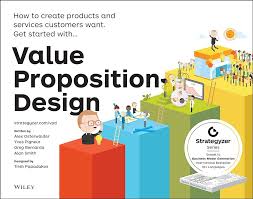Value Proposition Design: A Deep Dive into Crafting Winning Offers
Introduction
In today's competitive landscape, businesses must go beyond simply offering products and services. They must create compelling value propositions that resonate with their target customers, addressing their pain points and fulfilling their desires. Value Proposition Design (VPD) is a strategic framework that empowers organizations to develop these winning offers. This paper delves deeper into the intricacies of VPD, exploring its core concepts, tools, and real-world applications.
The Core Concepts of Value Proposition Design
At the heart of VPD lies the understanding of customer needs and the creation of offerings that address those needs effectively. Key concepts include:
- Customer Jobs: These are the tasks or problems that customers are trying to solve. They can be functional, social, or emotional in nature.
- Customer Pains: These are the frustrations, risks, and annoyances that customers experience while trying to get a job done.
- Customer Gains: These are the desired outcomes or benefits that customers seek.
By understanding these three elements, businesses can identify opportunities to create value and differentiate themselves from competitors.
The Value Proposition Canvas: A Visual Tool for VPD
The Value Proposition Canvas is a visual tool that helps businesses map out their value proposition and align it with customer needs. It consists of two sides:
- Customer Profile: This side focuses on understanding customer jobs, pains, and gains.
- Value Map: This side focuses on defining the product or service offering, pain relievers, and gain creators.
By filling out the canvas, businesses can visualize how their offerings address customer needs and identify areas for improvement.
Real-world Applications of VPD
VPD has been successfully applied by businesses of all sizes across various industries. Here are some examples:
- Technology Startups: Tech startups use VPD to identify market gaps, validate product ideas, and refine their value propositions to attract investors and customers.
- Established Companies: Established companies use VPD to innovate, launch new products or services, and revitalize existing offerings.
- Non-Profit Organizations: Non-profits use VPD to define their mission, identify target beneficiaries, and design programs that create maximum impact.
Advanced Techniques for VPD
To further enhance the effectiveness of VPD, consider these advanced techniques:
- Customer Journey Mapping: By mapping out the customer journey, businesses can identify pain points and opportunities for improvement at each stage.
- A/B Testing: Experimenting with different value propositions and measuring their impact can help optimize offerings.
- Lean Startup Methodology: Integrating VPD with the Lean Startup methodology enables rapid iteration and continuous improvement.
Conclusion
Value Proposition Design is a powerful tool that can help businesses create products and services that truly resonate with customers. By understanding customer needs, crafting compelling value propositions, and continuously iterating, organizations can achieve sustainable growth and success.
Additional Considerations
- The Role of Storytelling: Effective storytelling can help businesses communicate their value proposition in a compelling and memorable way.
- The Importance of Pricing: Pricing is a critical component of the value proposition. It should reflect the perceived value of the offering.
- The Impact of Brand: A strong brand can enhance the perceived value of a product or service.
By incorporating these elements into their VPD efforts, businesses can create even more powerful and impactful value propositions.
References
- Osterwalder, A., & Pigneur, Y. (2010). Business Model Generation: A Handbook for Visionaries, Game Changers, and Challengers. John Wiley & Sons.
- Ries, E. (2011). The Lean Startup: How Today's Entrepreneurs Use Continuous Innovation to Create Radically Successful Businesses. Crown Business.
- Strategyzer: https://www.strategyzer.com/
- Canvasly: https://creately.com/usage/business-model-canvas-template/
By delving deeper into these areas, you can create a comprehensive white paper that provides valuable insights into the power of Value Proposition Design for driving business development and growth.



